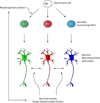Crosstalk among electrical activity, trophic factors and morphogenetic proteins in the regulation of neurotransmitter phenotype specification
- PMID: 26686293
- PMCID: PMC4818670
- DOI: 10.1016/j.jchemneu.2015.12.001
Crosstalk among electrical activity, trophic factors and morphogenetic proteins in the regulation of neurotransmitter phenotype specification
Abstract
Morphogenetic proteins are responsible for patterning the embryonic nervous system by enabling cell proliferation that will populate all the neural structures and by specifying neural progenitors that imprint different identities in differentiating neurons. The adoption of specific neurotransmitter phenotypes is crucial for the progression of neuronal differentiation, enabling neurons to connect with each other and with target tissues. Preliminary neurotransmitter specification originates from morphogen-driven neural progenitor specification through the combinatorial expression of transcription factors according to morphogen concentration gradients, which progressively restrict the identity that born neurons adopt. However, neurotransmitter phenotype is not immutable, instead trophic factors released from target tissues and environmental stimuli change expression of neurotransmitter-synthesizing enzymes and specific vesicular transporters modifying neuronal neurotransmitter identity. Here we review studies identifying the mechanisms of catecholaminergic, GABAergic, glutamatergic, cholinergic and serotonergic early specification and of the plasticity of these neurotransmitter phenotypes during development and in the adult nervous system. The emergence of spontaneous electrical activity in developing neurons recruits morphogenetic proteins in the process of neurotransmitter phenotype plasticity, which ultimately equips the nervous system and the whole organism with adaptability for optimal performance in a changing environment.
Keywords: Calcium signaling; Morphogenetic proteins; Neurotransmitter phenotype specification and plasticity; Sonic hedgehog; Spontaneous electrical activity; Target-derived trophic factors.
Copyright © 2015 Elsevier B.V. All rights reserved.
Figures


Similar articles
-
The role of voltage-gated calcium channels in neurotransmitter phenotype specification: Coexpression and functional analysis in Xenopus laevis.J Comp Neurol. 2014 Aug 1;522(11):2518-31. doi: 10.1002/cne.23547. Epub 2014 Apr 12. J Comp Neurol. 2014. PMID: 24477801 Free PMC article.
-
[Bone morphogenetic proteins and cholinergic neurons in the central nervous system].Rev Neurol. 2001 Dec 1-15;33(11):1054-60. Rev Neurol. 2001. PMID: 11785034 Review. Spanish.
-
Neurotransmitters as early signals for central nervous system development.Cell Tissue Res. 2001 Aug;305(2):187-202. doi: 10.1007/s004410000343. Cell Tissue Res. 2001. PMID: 11545256 Review.
-
Neurotransmitters and the development of neuronal circuits.Adv Exp Med Biol. 2007;621:104-15. doi: 10.1007/978-0-387-76715-4_8. Adv Exp Med Biol. 2007. PMID: 18269214 Review.
-
The role of early lineage in GABAergic and glutamatergic cell fate determination in Xenopus laevis.J Comp Neurol. 2006 Apr 20;495(6):645-57. doi: 10.1002/cne.20900. J Comp Neurol. 2006. PMID: 16506195
Cited by
-
Calcium Signaling in Vertebrate Development and Its Role in Disease.Int J Mol Sci. 2018 Oct 30;19(11):3390. doi: 10.3390/ijms19113390. Int J Mol Sci. 2018. PMID: 30380695 Free PMC article. Review.
-
Initial findings of striatum tripartite model in OCD brain samples based on transcriptome analysis.Sci Rep. 2019 Feb 28;9(1):3086. doi: 10.1038/s41598-019-38965-1. Sci Rep. 2019. PMID: 30816141 Free PMC article.
-
The body electric 2.0: recent advances in developmental bioelectricity for regenerative and synthetic bioengineering.Curr Opin Biotechnol. 2018 Aug;52:134-144. doi: 10.1016/j.copbio.2018.03.008. Epub 2018 Apr 21. Curr Opin Biotechnol. 2018. PMID: 29684787 Free PMC article. Review.
-
Protocol to derive postganglionic parasympathetic neurons using human pluripotent stem cells for electrophysiological and functional assessment.STAR Protoc. 2025 Jul 31;6(3):104001. doi: 10.1016/j.xpro.2025.104001. Online ahead of print. STAR Protoc. 2025. PMID: 40748761 Free PMC article.
-
A Subpopulation of Dopaminergic Neurons Coexpresses Serotonin in Ventral Mesencephalic Cultures But Not After Intrastriatal Transplantation in a Rat Model of Parkinson's Disease.Cell Transplant. 2017 Apr 13;26(4):679-691. doi: 10.3727/096368916X693707. Epub 2016 Nov 7. Cell Transplant. 2017. PMID: 27938488 Free PMC article.
References
-
- Abeliovich A, Hammond R. Midbrain dopamine neuron differentiation: factors and fates. Dev Biol. 2007;304:447–454. - PubMed
-
- Alberi L, Sgado P, Simon HH. Engrailed genes are cell-autonomously required to prevent apoptosis in mesencephalic dopaminergic neurons. Development. 2004;131:3229–3236. - PubMed
-
- Andersson E, Tryggvason U, Deng Q, Friling S, Alekseenko Z, Robert B, Perlmann T, Ericson J. Identification of intrinsic determinants of midbrain dopamine neurons. Cell. 2006;124:393–405. - PubMed
Publication types
MeSH terms
Substances
Grants and funding
LinkOut - more resources
Full Text Sources
Other Literature Sources

